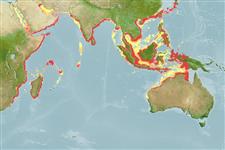Common names from other countries
Environment: milieu / climate zone / depth range / distribution range
Ecologie
Benthopelagisch; brakwater; diepteverspreiding 0 - 55 m (Ref. 409). Tropical; 31°N - 32°S, 30°E - 138°E
Indo-West Pacific: Eastern Africa to Hong Kong and Australia.
Length at first maturity / Size / Gewicht / Leeftijd
Maturity: Lm ? range ? - ? cm Max length : 3.2 cm BL mannelijk/geslacht niet bekend; (Ref. 409); 4.8 cm BL (female)
Rostrum, which has two dorsal denticles or teeth, is shorter than eyes. Elongated first 3 pereiopods and no fourth and fifth pereiopods. Larger female than males. Color: in life, whole body almost transparent. Milky or yellowish when dead.
Marketed either dried, boiled, salted, fermented, fresh, or processed in other ways; consumed locally in the form of seasoning (shrimp paste/sauce) (Ref. 409). Planktonic in life. Inhabits estuarine waters with mangroves (Ref. 374). Marine or brackish, but usually brackish and fished in the intertidal zone, estuaries (Ref. 409) and mangroves (Refs. 409, 121475). In general, it is a zooplanktivorous omnivore, wherein it primarily feeds on copepods, ostracods, other crustaceans, and molluscan veligers. It is observed to forage intensively after midnight (Ref. 104021). Omnivorous suspension feeder (Ref. 105380).
Life cycle and mating behavior
Geslachtsrijpheid | Voortplanting | Kuitschieten | Eieren | Fecundity | Larven
Members of the order Decapoda are mostly gonochoric. Mating behavior: Precopulatory courtship ritual is common (through olfactory and tactile cues); usually indirect sperm transfer.
Pérez Farfante, I. and B. Kensley. 1997. (Ref. 75620)
Status op de Rode Lijst van het IUCN (Ref. 130435)
Status bij CITES (Ref. 108899)
Not Evaluated
Not Evaluated
Gebruik door de mens
Visserij: commercieel
FAO - Visserij: landings | FishSource |
Tools
Internet-bronnen
Estimates based on models
Preferred temperature
(Ref.
115969): 24.8 - 29.1, mean 28.3 (based on 1292 cells).
Weerstandsvermogen
Hoog, minimale populatieverdubbelingstijd minder dan 15 maanden (K=1.2).
